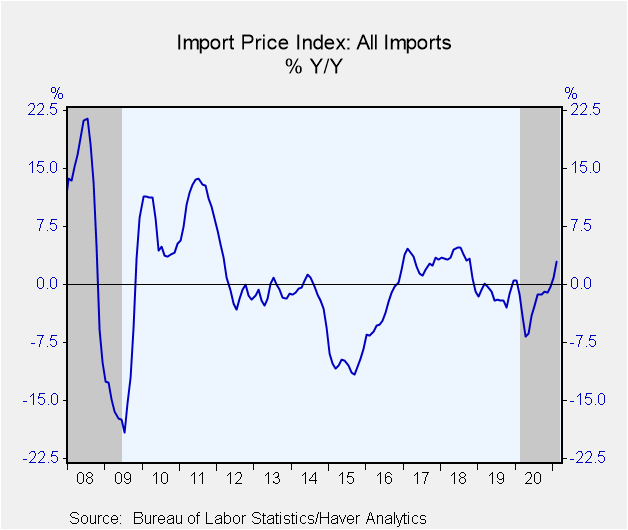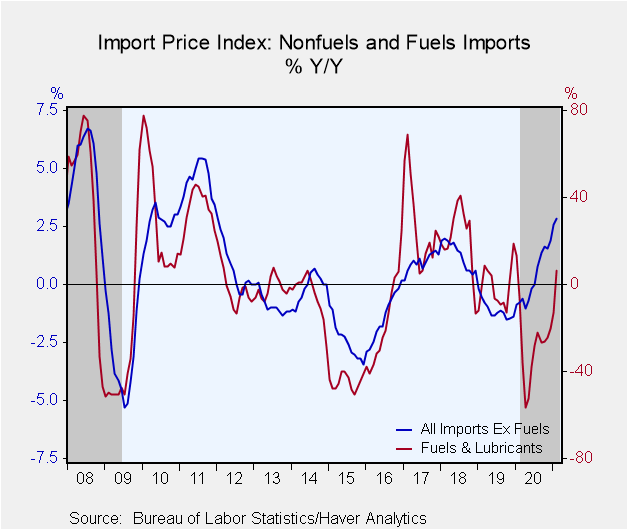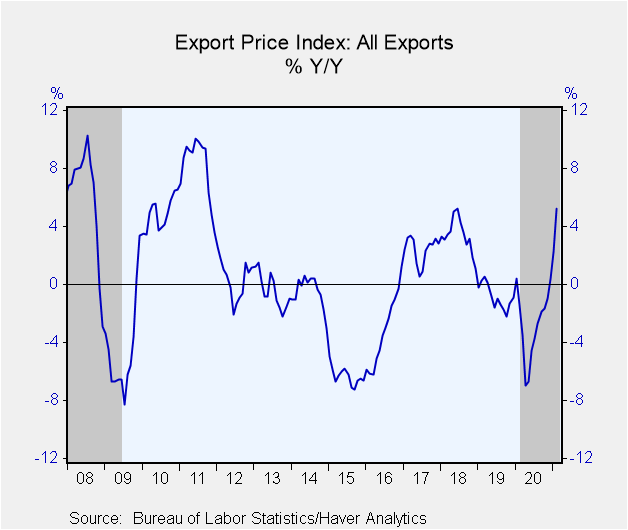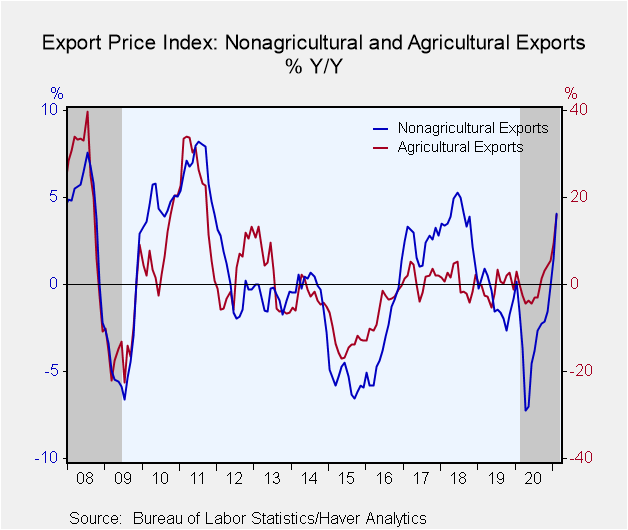 Global| Mar 16 2021
Global| Mar 16 2021U.S. Import and Export Prices Rise Further in February
by:Sandy Batten
|in:Economy in Brief
Summary
• Import prices rose 1.3% in February with imported fuel prices up 11.1%. • Annual increase in nonfuel import prices highest since January 2012. • Export prices increased 1.6%. Annual increase highest since June 2018. Import prices [...]
• Import prices rose 1.3% in February with imported fuel prices up 11.1%.
• Annual increase in nonfuel import prices highest since January 2012.
• Export prices increased 1.6%. Annual increase highest since June 2018.
Import prices increased a slightly larger-than-expected 1.3% m/m (3.0% y/y) in February on top of an unrevised 1.4% m/m gain in January. The Action Economics Forecast Survey anticipated a 1.2% m/m gain in February. The 3.0% y/y increase was the largest since October 2018. A 11.1% m/m (6.5% y/y) jump in fuel prices following a 9.0% m/m increase in January was the major factor behind the rise in import prices in February. The 6.5% y/y rise in fuel prices was the first yearly increase since January 2020. An 11.3% m/m rise in petroleum prices and an 11.2% m/m advance in natural gas prices each contributed to the February increase in imported fuel prices. Nonfuel import prices rose a modest 0.4% m/m (2.8% y/y) in February after a 0.9% m/m increase in January. The 2.8% y/y rise in nonfuel prices was the largest since January 2012. Prices in all of the major end-use categories rose in February, though apart from fuel and foods, feeds, beverages (1.6% m/m), the increases were very small. These figures are not seasonally adjusted and do not include import duties.
After posting a 2.5% m/m jump in January, the largest monthly gain in the series history, export prices increased a larger-than-expected 1.6% m/m (5.2% y/y) in February. The Action Economics Forecast Survey had expected a 1.1% m/m gain. The 5.2% y/y rise was the largest since June 2018. The price index for agricultural exports rose 2.9% m/m (16.1% y/y) following a 6.0% jump in the previous month. The February gain was primarily due to higher soybean and corn prices. The 16.1% y/y increase was the largest annual gain since September 2011. Prices of nonagricultural exports increased 1.5% m/m (4.1% y/y) in February after a 2.2% m/m gain in January. Prices rose in all major end-use categories in February with the largest being a 3.6% m/m increase in prices of industrial supplies and materials, led by an 8.8% m/m increase in exported fuel prices.
The import and export price series can be found in Haver's USECON database. Detailed figures are available in the USINT database. The expectations figure from the Action Economics Forecast Survey is in the AS1REPNA database.
| Import/Export Prices (NSA, %) | Feb | Jan | Dec | Feb Y/Y | 2020 | 2019 | 2018 |
|---|---|---|---|---|---|---|---|
| Imports - All Commodities | 1.3 | 1.4 | 1.0 | 3.0 | -2.5 | -1.3 | 3.1 |
| Fuels | 11.1 | 9.0 | 7.3 | 6.5 | -27.8 | -2.1 | 20.8 |
| Nonfuels | 0.4 | 0.9 | 0.4 | 2.8 | 0.3 | -1.1 | 1.3 |
| Exports - All Commodities | 1.6 | 2.5 | 1.2 | 5.2 | -2.8 | -0.9 | 3.4 |
| Agricultural | 2.9 | 6.0 | 1.0 | 16.1 | -0.3 | -0.4 | 0.6 |
| Nonagricultural | 1.5 | 2.2 | 1.3 | 4.1 | -3.0 | -0.9 | 3.7 |
Sandy Batten
AuthorMore in Author Profile »Sandy Batten has more than 30 years of experience analyzing industrial economies and financial markets and a wide range of experience across the financial services sector, government, and academia. Before joining Haver Analytics, Sandy was a Vice President and Senior Economist at Citibank; Senior Credit Market Analyst at CDC Investment Management, Managing Director at Bear Stearns, and Executive Director at JPMorgan. In 2008, Sandy was named the most accurate US forecaster by the National Association for Business Economics. He is a member of the New York Forecasters Club, NABE, and the American Economic Association. Prior to his time in the financial services sector, Sandy was a Research Officer at the Federal Reserve Bank of St. Louis, Senior Staff Economist on the President’s Council of Economic Advisors, Deputy Assistant Secretary for Economic Policy at the US Treasury, and Economist at the International Monetary Fund. Sandy has taught economics at St. Louis University, Denison University, and Muskingun College. He has published numerous peer-reviewed articles in a wide range of academic publications. He has a B.A. in economics from the University of Richmond and a M.A. and Ph.D. in economics from The Ohio State University.










